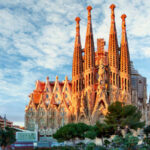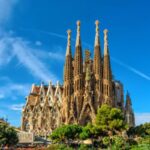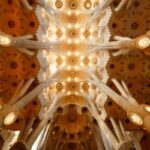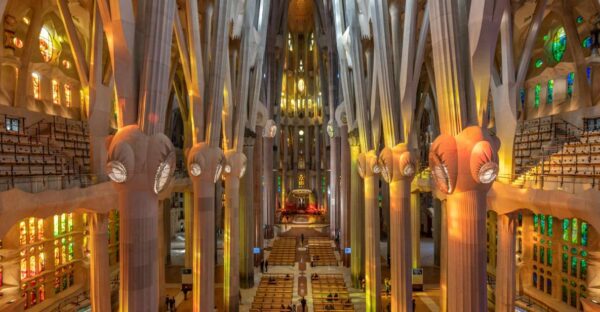
- Inside the Architectural Marvel: Understanding the Sagrada Familia’s Design
- The Symbolism of Light: Exploring the Spiritual Significance of Sagrada Familia
- A Journey Through Time: The Construction History of Barcelona's Sagrada Familia
- Gaudí's Vision: The Artistic Inspirations Behind the Sagrada Familia
- Visiting the Sagrada Familia: Tips for an Unforgettable Experience in Barcelona
- Exploring the Facades: The Unique Features of Sagrada Familia’s Exterior
Barcelona's Sagrada Familia stands as a testament to the genius of architect Antoni Gaudí, captivating visitors with its intricate design and spiritual significance. This monumental basilica, still under construction, combines elements of Gothic and Art Nouveau styles, creating a unique architectural experience that draws millions each year.
In this exploration of the renowned landmark, titled Inside the Icon: Exploring Barcelona's Sagrada Familia, we delve into the mesmerizing details that adorn its interior. From the stunning stained glass windows to the towering columns resembling trees, every aspect invites awe and contemplation, making it a true masterpiece of religious and artistic expression.
Inside the Architectural Marvel: Understanding the Sagrada Familia’s Design
The design of the Sagrada Familia reflects Gaudí's vision of nature intertwined with spirituality. His inspiration from organic forms is evident in the basilica's columns, which are designed to mimic the structure of trees. This innovative approach allows the interior to be filled with light and air, enhancing the sense of tranquility and connection to the divine.
One of the most striking features of the interior is the play of light created by the colorful stained glass windows. Each window tells a story, contributing to the overall narrative of the basilica. The use of vibrant colors changes throughout the day, casting a mesmerizing glow that fills the space with a spiritual ambiance. Important elements include:
- Symbolism: Each color represents different themes, such as hope and redemption.
- Design Variations: Windows vary in size and shape, contributing to a dynamic visual experience.
- Natural Light: The interplay of light reinforces the connection between the earthly and the heavenly.
The basilica's structure also features an intricate layout that is both functional and symbolic. The plan of the Sagrada Familia resembles a Latin cross, which is significant in Christian architecture. This layout allows for a spacious nave and side aisles that accommodate both worshippers and visitors, ensuring a seamless flow through the sacred space.
Gaudí's use of geometry and mathematics also plays a crucial role in the design. The incorporation of hyperboloids, paraboloids, and other geometric shapes not only enhances the aesthetic appeal but also contributes to the stability and durability of the structure. This scientific approach reflects Gaudí's belief that architecture should harmonize with nature, demonstrating that beauty and function can coexist in perfect balance.
The Symbolism of Light: Exploring the Spiritual Significance of Sagrada Familia
The Sagrada Familia embodies a profound symbolism of light, which plays a pivotal role in its spiritual significance. Gaudí believed that light is a manifestation of the divine, making it essential to create an atmosphere that encourages reflection and worship. The careful placement of windows allows sunlight to filter into the basilica, illuminating the interior with a warm glow that transforms throughout the day.
The interplay of light and color within the Sagrada Familia is not only visually captivating but also deeply meaningful. Each stained glass window is intentionally designed to evoke specific emotions and spiritual themes. Key aspects include:
- Emotional Resonance: Colors like blue and green symbolize tranquility and hope.
- Spiritual Journey: As one moves through the space, the changing light reflects different stages of spiritual awakening.
- Architectural Harmony: The design ensures that natural light enhances the overall beauty and sanctity of the space.
Moreover, the structure itself is designed to amplify the experience of light. The towering columns, reminiscent of trees, create a forest-like environment that invites visitors to feel connected to nature and the divine. This unique approach fosters a sense of peace and contemplation, allowing individuals to reflect on their spiritual journeys.
In conclusion, the Sagrada Familia serves as a powerful symbol of light, intricately woven into its design and purpose. Gaudí's vision transcends mere architecture, offering a sacred space that inspires awe and reverence, encouraging all who enter to seek a deeper understanding of their spirituality.
A Journey Through Time: The Construction History of Barcelona's Sagrada Familia
The construction history of Barcelona's Sagrada Familia is as intricate as its design, beginning in 1882 under the direction of architect Francisco de Paula del Villar. However, it was Antoni Gaudí who took over the project in 1883, infusing it with his unique vision and innovative ideas. His work has transformed the basilica into a landmark that reflects both his artistic genius and a profound spiritual journey.
Over the years, the construction has faced numerous challenges, including funding shortages, political turmoil, and the effects of war. Despite these hurdles, the dedication to Gaudí's original plans has remained steadfast. Some key milestones in the construction history include:
- 1882: Groundbreaking ceremony and initial design by Villar.
- 1936: Construction halted due to the Spanish Civil War.
- 2010: The basilica was consecrated by Pope Benedict XVI.
- Ongoing: Expected completion in the coming decades, with a target year of 2026.
Gaudí's innovative techniques and materials have played a significant role in the basilica's enduring appeal. The use of natural forms and geometric designs has led to a structure that not only aspires to reach new heights but also reflects the harmony of nature. This interplay between architecture and the environment is a testament to Gaudí's belief that buildings should coexist with their surroundings.
Today, the Sagrada Familia continues to evolve, with modern technology aiding in its construction while adhering closely to Gaudí's original vision. This blend of tradition and innovation ensures that the basilica will stand as a magnificent symbol of faith and artistry for future generations. As the completion date approaches, anticipation grows around the full realization of Gaudí's dream, making it a profound journey through time for both architects and visitors alike.
Gaudí's Vision: The Artistic Inspirations Behind the Sagrada Familia
Antoni Gaudí's vision for the Sagrada Familia is deeply rooted in his appreciation for nature and its forms. His artistic inspirations draw heavily from the natural world, leading to a design that harmonizes architectural elements with organic motifs. This connection to nature is evident in the basilica's sculptural details, which mimic the shapes of plants and animals, creating a seamless integration of the built environment with the living world surrounding it.
One of the most significant aspects of Gaudí's artistic vision is his use of color and light. He believed that colors could evoke emotions and convey spiritual messages. The intricate stained glass windows serve not only as decorative elements but also as storytelling devices. The color palette used in these windows reflects Gaudí's desire to create a space that nurtures the soul and enhances the spiritual journey of each visitor. Key themes include:
- Nature's Palette: Colors are inspired by the flora and fauna of the region.
- Emotional Impact: The arrangement of colors is designed to elicit specific feelings during worship.
- Dynamic Light: The changing sunlight throughout the day alters the atmosphere within the basilica.
Moreover, Gaudí's fascination with geometry is evident in the structural design of the Sagrada Familia. He utilized complex shapes such as hyperboloids and paraboloids to achieve both beauty and strength, allowing the basilica to rise toward the heavens. This mathematical precision not only enhances the aesthetic quality but also ensures the stability of the structure, reflecting Gaudí's belief that architecture must be both beautiful and functional.
Ultimately, Gaudí's artistic inspirations culminate in a vision that transcends mere construction. The Sagrada Familia stands as a profound representation of faith and creativity, inviting visitors to explore its depths while contemplating the divine presence in their lives. Through this masterpiece, Gaudí invites us to connect with both the natural world and our spiritual essence, making the Sagrada Familia a truly unique architectural marvel.
Visiting the Sagrada Familia: Tips for an Unforgettable Experience in Barcelona
When planning your visit to the Sagrada Familia, consider booking your tickets online in advance. This not only saves you time by avoiding long queues but also guarantees your preferred time slot. Additionally, choosing a guided tour can enhance your experience by providing you with in-depth insights into the basilica's rich history and architectural details, making your visit even more memorable.
Timing is crucial when visiting this iconic landmark. Early morning or late afternoon are the best times to explore, as the lighting during these hours creates a stunning ambiance inside the basilica. Moreover, visiting on weekdays may help you avoid large crowds, allowing for a more serene experience as you take in the breathtaking architecture and spiritual atmosphere.
Be sure to set aside ample time to explore not just the main church but also the surrounding areas. The Sagrada Familia is located in a vibrant neighborhood filled with parks, cafes, and shops. Consider taking a leisurely stroll in Parc de Gaudí, which offers a lovely view of the basilica. This way, you can fully immerse yourself in the artistic influences that define the essence of Gaudí's work.
Finally, remember to respect the sacred nature of the Sagrada Familia during your visit. Maintain a quiet demeanor, especially inside the basilica, as it serves as a place of worship. Adhering to the guidelines and being mindful of other visitors will ensure that everyone can appreciate the beauty and serenity of this extraordinary site.
Exploring the Facades: The Unique Features of Sagrada Familia’s Exterior
Exploring the facades of the Sagrada Familia reveals a rich tapestry of artistic expression that captures the essence of Gaudí’s vision. The basilica's Nativity Facade is a celebration of life and nature, adorned with intricate sculptures that depict the birth of Christ. This facade contrasts beautifully with the Passion Facade, which embodies a more somber and austere reflection on the suffering of Jesus. Each facade tells a unique story, inviting visitors to engage with its profound symbolism.
Key features of the facades include:
- Intricate Sculptures: Each figure is meticulously crafted, contributing to the narrative of Christ's life.
- Natural Elements: Gaudí integrated organic shapes and forms, blurring the lines between architecture and nature.
- Symbolic Details: Every element serves a dual purpose of aesthetics and spirituality, creating a deep sense of reverence.
Another remarkable aspect of the Sagrada Familia's exterior is the use of light and shadow. The design of the facades ensures that sunlight interacts dynamically throughout the day, creating a mesmerizing play of light that enhances the architectural details. This thoughtful integration allows for a transformative experience, as the facades evolve with the changing light, inviting contemplation and reflection.
In conclusion, the facades of the Sagrada Familia are not merely decorative; they serve as a canvas of storytelling and spiritual exploration. Through the combination of sculptural artistry and architectural innovation, Gaudí's masterpiece invites each visitor to delve deeper into its symbolism and beauty, making every encounter with the structure a unique journey into the heart of faith and creativity.
 Discover the Magnificent Sagrada Familia in Barcelona's Vibrant District | Barcelona Turisme
Discover the Magnificent Sagrada Familia in Barcelona's Vibrant District | Barcelona Turisme Unveiling the Majestic Transformation of Barcelona's Sagrada Familia Church
Unveiling the Majestic Transformation of Barcelona's Sagrada Familia Church Explore the Astonishing Interior of Barcelona's Sagrada Familia Church
Explore the Astonishing Interior of Barcelona's Sagrada Familia Church Discover the Majesty of Sagrada Familia: Barcelona's Iconic Gem
Discover the Majesty of Sagrada Familia: Barcelona's Iconic GemIf you want to know other articles similar to Inside the Icon: Exploring Barcelona's Sagrada Familia you can visit the category WHERE YOU CAN GO.
Deja una respuesta










Read more!